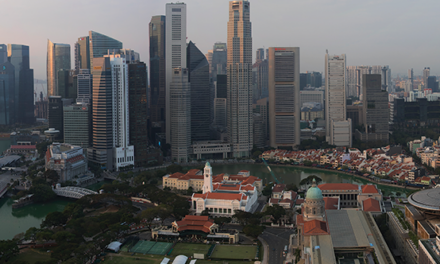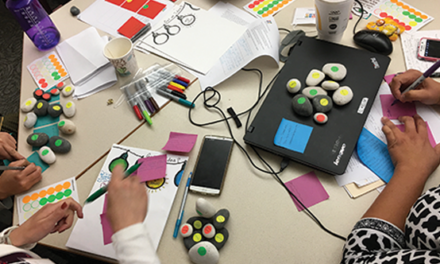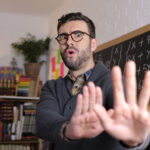On the surface, negative comments by students about race, gender, or sexual preference may seem to be part of the benign banter of youth, but they’re exactly where teachers should start their battle — and lessons — to build a better child and world.
Every teacher has heard them, often several times a day: comments that rub them the wrong way but seem too innocent to challenge. “Boys will be boys,” Mr. Shubert says in response to a playground tussle. After Ernie gets 99% on the math quiz, Jamie blurts, “Figures; he’s Chinese.” “That’s so gay,” Tricia moans when her teacher assigns tough homework. Teachers who want to help students become competent, caring adults cannot just help Ernie learn math. They need to help Mr. Shubert, Jamie, and Tricia see the harm in their seemingly innocuous comments.
While subdued forms of everyday prejudice may seem harmless, appearances can be deceiving. Such commonplace prejudices form the foundation upon which more extreme acts of prejudice build. And they also leave us vulnerable to costly errors of judgment that can have tragic consequences. That is why addressing prejudice in the classroom is as crucial to our youth’s education as learning to read.
Comprehending the pyramid principle of prejudice and its profound educational implications is the first step toward reducing the violence, discrimination, hatred, and bigotry that spread like wildfires in the dry climate created by everyday prejudice. Before we explain the pyramid principle, though, let’s take a quick scan of the psychology of prejudice and how it relates to discrimination and the “-isms.”
Every act at the bottom of the pyramid is shouldering part of the responsibility for those acts residing above.
The psychology of prejudice
We all know what prejudices are. They are prejudgments that rely on stereotypes (Allport, Clark, & Pettigrew, 1979). They are assumptions made about people based on their association with certain groups. Prejudices arise and persist because they serve important social and psychological functions.
In one sense, prejudices reflect an inevitable part of human cognition. The world is such a complex place that simplification is necessary for understanding. We would be overwhelmed if we tried to approach each new individual with no preconceived ideas. Before we even consciously think about it, we already have formed opinions about that boy who walked into class on the first day sporting a Mohawk and skull shirt. Stereotypes are cognitive maps that help us simplify our highly complex social world. To some extent, they are necessary for mental efficiency and ease (Dalrymple, 2007). Still, that efficiency comes at the cost of accuracy and fairness.
The psychological roots of prejudice also extend deep into our emotional selves (Whitley & Kite, 2010). One major source of prejudice is the pervasive human need for positive self-regard. We want to feel good about ourselves and the groups with which we identify. As a male, I want to feel good about being a man. As a member of this nation, I want to feel patriotic. A powerful way to buttress our sense of worthiness, competence, and belonging is to compare ourselves to others we perceive as inferior. We might muse: “I’m so glad I’m American; we’re better than the French,” even if we’re sensitive enough not to say it aloud. This need for favorable social comparison provides fuel to the fires of prejudice. Prejudices, after all, guarantee in advance that “we” will compare favorably to “them.”
Prejudices support numerous other psychological functions that need not concern us here. But one more deserves special mention. For those who are relatively privileged in society, prejudices can blind us to the injustices that protect our privileges. For example, not long ago a wealthy presidential candidate who spent his early years in security and abundance, who attended expensive private schools and benefitted from the models and social networks that his family, neighborhood, and schools afforded, still claimed that his wealth was all his own doing (Parenne, 2012). With that incredulous claim comes implicit blame: Those who are caught in poverty can be blamed for their plight. From this vantage point, the structural inequalities that perpetuate class divisions are hidden. Blaming the victim (Ryan, 1971) is a resilient form of subtle prejudice; it takes a hundred forms, and it benefits the privileged in a thousand ways.
Prejudice and discrimination
We’ve hinted at the deep connection between prejudice and discrimination. While prejudice is largely attitudinal, discrimination is more behavioral. Discrimination refers to actions, policies, or social arrangements that disadvantage people based on the group to which they belong (Whitley & Kite, 2010). The Boy Scouts long-standing exclusion of gay boys was discriminatory. Fortunately, the Scouts recently reversed this policy (Eckholm, 2013), though discrimination persists in that openly gay troop leaders are banned.
Discrimination is often codified in the policies and practices of organizations. Continuing discriminatory policies does not depend on the individual prejudices of those who implement them. For example, imagine that a college requires a minimum score on a standardized test before granting admission. Imagine further (it should be easy) that the test is culturally biased. If admission officers simply apply the rules, they can further discrimination even though individually they may not be prejudiced against the disadvantaged applicants.
Prejudice and the “-isms”
Prejudice is often confused with the “-isms,” such as racism or classism. However, there is an important difference. Prejudice refers to the attitudes and beliefs held by an individual or group that inform their decisions and actions. When we refer to a statement as racist, however, we mean something more than that the statement reflects a racial prejudice. A statement is racist when the prejudice it expresses reinforces the prevailing racial division of power and privilege (Tatum, 1997). The “-isms” represent the ways that certain prejudices and practices perpetuate and fortify unequal access to the goods of society (social, economic, political, etc.). Thus, sexism goes beyond individual prejudice; it occurs when gender prejudice buttresses unequal power hierarchies that privilege males at the expense of females. The “-isms” are fundamentally about prejudices combining with power, though the power may be exercised in subtle and indirect ways.
The “Pyramid Principle” of prejudice
In society, when our sight is sharpened by honesty, we see that the blatant acts of hate or discrimination carried out by the troubled few are actually ugly and exaggerated reflections of imperfections in ourselves. The pyramid principle of prejudice states that the blatant prejudices of the few are magnifications of the latent prejudices of the many (Shields, 1986).
Have you ever been to a carnival fun house with mirrors that distort your image, creating exaggerated and ugly reflections of yourself? Such mirrors provide an analogy for the pyramid principle. Just as the twisted image in the fun house mirror could not exist without someone standing in front of it, neither would gross acts of violence be possible without the “minor” violence of widespread and largely inconspicuous prejudice that lines the base of the prejudice pyramid.

The bottom of the pyramid is where most people can be found. The prejudices and discriminatory acts of people metaphorically residing at the base often go unrecognized; they have a quiet, inconspicuous, everyday quality to them. If confronted, most people at the base would be puzzled; they don’t consider themselves prejudiced. As you move higher up the pyramid, fewer and fewer people are represented, but the prejudicial attitudes and discriminatory actions become increasingly overt, obvious, and extreme. At the top of the pyramid are the truly horrendous acts carried out by tiny numbers.
The key point is that every vertical movement up the pyramid builds from and depends upon the attitudes and behaviors established by the levels below. Still, people at each level typically perceive “the problem” to be limited to those higher in the pyramid. “Yeah, I laughed at the [racist] joke, but I don’t use the ‘n’ word,” says Malcolm as he refuses to accept any sense of personal responsibility for the continuation of racial prejudice in society.
Life at the base
Most people, in most situations, neither think of themselves as prejudiced, nor do they exhibit overtly prejudicial speech or behavior. But none of us are completely free of bias, most of which is unconscious. As psychologists over the past couple decades have demonstrated, most of our thinking occurs outside conscious awareness (Evans, 2009). In terminology popularized by Nobel Prize-winning researcher Daniel Kahneman (2011), our “fast thinking” is invisible to our conscious mind. And it is within our fast thinking that most biases and prejudices operate (Anderson, 2010).
For those who are relatively privileged in society, prejudices can blind us to the injustices that protect our privileges.
Consider gender. In schools, stereotypes about “boys” and “girls” are as common as pencils. Typically, comments about “boys’ toys” and “girls’ toys” by a kindergarten teacher would raise no eyebrows. Complimenting girls for their looks and boys on their athleticism may occur with little notice. When Tom describes Kim as “feminine,” he is likely unaware of how his “fast thinking” engaged in complex comparisons between observed attributes and cultural stereotypes. No doubt he would reject the idea that his comment about Kim is prejudicial. Still, all references to “masculinity” or “femininity” are premised on stereotypical depictions of gender that can’t help but reinforce a bias against those who do not fit or conform to the dominant cultural patterns of gender expression.
Consider race. Everyday racism is widespread but largely hidden, especially to those who are not victimized by it. White dolls are more common in preschools than black dolls. An active African-American boy may be described as “aggressive,” while a white boy exhibiting the same behaviors may be described as “spirited.” Even without recognizing it, the teacher of a diverse classroom may be more alert to rule violations by black than white children. The examples could be multiplied a hundredfold. While the cumulative effects of such patterns of prejudice and discrimination are weighty, each individual instance seems inconsequential.
Most prejudices at the base of the pyramid have few immediate and obvious negative outcomes. Their cost comes from their cumulative effect and the launching pad they provide for expressions of prejudice at higher levels. Still, even unobserved biases can sometimes explode in tragedy. This may well have been the situation in the Trayvon Martin case. Though no one can get inside George Zimmerman’s head as he followed, then shot the unarmed teenager, it is improbable that he was immune to stereotypes that link black male teenagers with crime. Even George Zimmerman may not be aware of his own “fast thinking” about race. The fact that we are becoming an increasingly armed society paves the way for subtle prejudices to be amplified by weapons into disastrous encounters.
Moving up the pyramid
Stereotypes about blue and pink clothes are at the base of the pyramid. Higher up are stereotypes about intellectual competencies and capacities that channel boys toward math and science and girls toward art and literature. While girls may benefit from learning poetry, there is no poetic justice in this; everyone should have equal access to every field of study. Similarly, racial prejudices at the mid-range of the pyramid are more explicit than those at the base. Stereotypes that claim blacks are “natural” athletes hurt African-Americans in the classroom. In many urban schools, there is a continuous flow of students into the justice system; the school-to-prison pipeline is fueled by stereotypes about “what works” with disadvantaged youth.
I was at a workshop recently where a coach from a predominantly Native American high school recounted how his team often endures humiliating racially charged jeers and gestures by fans of opposing teams. Group dynamics can sometimes whip subtle prejudices into actions higher in the pyramid.
Prejudice against gays and lesbians, though lessening, is still common on middle and senior high school campuses where these youth face frequent social marginalization from their classmates. The tragic fate of 15-year-old Lawrence King illustrates multiple levels of the pyramid (Saillant, 2008). Throughout Lawrence’s life students made seemingly innocuous remarks or jokes that expressed prejudice against gay people. Metaphorically standing on their backs, a few carried it further and Lawrence was bullied, the victim of name calling and wet paper towels thrown at his head. Then, one student climbed to the top of the prejudice pyramid. On Feb. 12, 2008, Brandon McInerney, 14, shot Lawrence twice in the head.
Of course, at the pyramid’s peak are attitudes and behaviors that are so extreme that they are widely condemned. Rising to this level are the brutal but relatively rare acts of hate groups. Not far below are overt patterns of discrimination in such things as housing, wages, employment, and health care. These clearly remain significant societal problems. But whose responsibility is it to deal with prejudice and discrimination in its various forms?
The remedy: Legal or educational?
One last dimension of the pyramid is this: The higher you go in the pyramid, the more the legal system is the appropriate remedy; the lower you go, the more it is the educational system that needs to take responsibility. If housing discrimination is occurring, it should be challenged in court. If women don’t receive equal pay for equal work, laws need to be enforced. In states where gay and lesbian couples cannot marry, constitutions need to change.
When you get closer to the base of the pyramid, the remedies are necessarily educational rather than legal. To collapse the whole pyramid, we need to attack it at its base. That is where schools and teachers need to shoulder responsibility.
Unfortunately, educators who desire to tackle the base of the prejudice pyramid may be silenced by the retort, “You’re just being PC.” Many individuals are so fearful of being accused of political correctness that so-called minor injustices are readily tolerated. “It’s not that serious,” we say to ourselves. “So what if we refer to ‘Muslim terrorists’ as if that communicates something valid? So what if we don’t confront a student who says, ‘that’s so gay’ in the hallway?” Yet these minor expressions of prejudice are important. Every act at the bottom of the pyramid is shouldering part of the responsibility for those acts residing above.
Concretely, what can educators do? The first step is self-awareness. Despite its many forms, all prejudices work through creating some form of “us/them” dichotomy. A white girl and a Latina girl get in a fight during recess, and the teacher on duty — who just so happens to be white — automatically singles out the Latina as the aggressor. While readers may feel justifiable anger at that teacher, we need to look in the mirror. We all behave similarly. What are the “us/them” divisions in our own thinking? We will never eliminate them completely, but we can make progress.
The second step is to speak up. I’m not suggesting that each expression of everyday prejudice needs to be met with a protracted debate. But silence should not be our default option. Silence endorses. Silence leaves harmful patterns uninterrupted. Speak with humility and grace, but speak up when everyday prejudices are expressed or exhibited.
Addressing prejudice in the classroom is as crucial to our youth’s education as learning to read.
Hopefully, speaking up can lead to schoolwide dialogue. Spotting prejudices in others is easier than seeing them in ourselves, and an open, honest discussion can be helpful. Dealing with the adult culture of the school is a prerequisite to dealing effectively with students and their peer culture.
Schools with character education programs (Shields, 2011) can integrate prejudice reduction efforts into them since a concern for diversity and social justice are cornerstones of character. Moreover, pedagogical strategies widely used in character education also work well to reduce prejudices. For example, cooperative learning can be effective for both developing character and addressing cultural difference (Johnson & Johnson, 2012). Done right, competition, too, can have its place (Shields & Bredemeier, 2009, 2010). The old “boys against the girls” strategy for creating teams, however, is out. If competition is used, people with diverse backgrounds must be on the same team where they can build bridges.
Finally, take advantage of opportunities to address the plethora of “-isms” when doing so fits within the curriculum. Virtually every subject can be a means to address problems of prejudice and associated patterns of discrimination. If you teach math, discuss the cultural stereotypes that interfere with some students progressing as well as others. If you teach biology, why not challenge the false dualism of male and female? If you teach health and physical education, why not reflect on why there are significant health disparities across racial and ethnic groups or why gay athletes have a hard time coming out? If you teach literature, social studies, or history, the possibilities are nearly endless. Whatever your grade level or subject area, a quick Internet search will reveal an abundance of resources for addressing prejudices and social injustice.
There is much that you can do, and it begins with comprehending the realities captured by the pyramid principle of prejudice.
References
Allport, G., Clark, K., & Pettigrew, T. (1979). The nature of prejudice: 25th-anniversary edition. New York, NY: Basic Books.
Anderson, K. (2010). Benign bigotry: The psychology of subtle prejudice. Cambridge, MA: Cambridge University Press.
Dalrymple, T. (2007). In praise of prejudice: The necessity of preconceived ideas. New York, NY: Encounter Books.
Eckholm, E. (2013, May 23). Boy Scouts end longtime ban on openly gay youths. New York Times. www.nytimes.com/2013/05/24/us/boy-scouts-to-admit-openly-gay-youths-as-members.html?_r=0
Evans, J.S. (2009). Dual-processing accounts of reasoning, judgment, and social cognition. Annual Review of Psychology, 59, 255-278.
Johnson, D.W. & Johnson, R.T. (2012). Restorative justice in the classroom: Necessary roles of cooperative context, constructive conflict, and civic values. Negotiation and Conflict Management Research, 5 (1) 4-28.
Kahneman, D. (2011). Thinking, fast and slow. New York, NY: Farrar, Straus, and Giroux.
Pareene, A. (2012, September 18). Mitt Romney, self-made man. Salon.com. www.salon.com/2012/09/18/mitt_romney_self_made_man/
Ryan, W. (1971). Blaming the victim. New York, NY: Pantheon Books.
Saillant, C. (2008, October 3). Teen accused of killing his gay classmate had white supremacist materials. Los Angeles Times. http://articles.latimes.com/2008/oct/03/local/me-briefs3.S4
Shields, D.L. (1986). Growing beyond prejudices: Overcoming hierarchical dualism. Mystic, CT: Twenty-third publications.
Shields, D.L. (2011). Character as the aim of education. Phi Delta Kappan, 92 (8), 48-53.
Shields, D. & Bredemeier, B. (2010). Competition: Was Kohn right? Phi Delta Kappan, 91 (5), 62-67.
Shields, D. & Bredemeier, B. (2009). True competition: A guide to pursuing excellence in sport and society. Champaign, IL: Human Kinetics.
Tatum, B.D. (1997). “Why are all the black kids sitting together in the cafeteria?” And other conversations about race. New York, NY: Basic Books.
Whitley, B.E. & Kite, M.E. (2010). The psychology of prejudice and discrimination, 2nd ed. Belmont, CA: Wadsworth Cengage.
CITATION: Shields, D.L. (2014). Deconstructing the pyramid of prejudice. Phi Delta Kappan, 95 (6), 20-24.
ABOUT THE AUTHOR

David Light Shields
DAVID LIGHT SHIELDS is teacher education program coordinator in the department of social and behavioral sciences, Saint Louis Community College – Meramec, St. Louis, Mo.












